Are you a novice smoker looking for the best meat to smoke for beginners?
Look no further!
Here are 20 of the best meats for beginner smokers.
From pork shoulder to brisket and everything in between, each of these cuts smokes perfectly and can be prepared with minimal effort.
Explore new flavor combinations by adding your favorite seasoning blends or rubs, or simply keep things simple and stick with traditional smoking techniques.
Whether you’re entertaining guests or just having dinner at home, enjoying succulent smoked meats is a temptation too hard to resist.
In a rush? Here is the quick answer:
The best meat to smoke for beginners is chicken. It is an easy cut of meat that usually takes less than two hours to cook and the skin can be removed if desired. The smoked flavor will give your meal a unique taste that is sure to impress.

The 20 Best Meats to Smoke for Beginners
Smoking meat can be a great way to add an extra layer of flavor and texture.
However, it is important to choose the right type of meat for smoking as some meats are better suited than others.
If you’re new to this cooking technique, here are twenty types of meats that are ideal for beginners:
1. Whole Chicken

Smoked whole chickens are a great choice for those just starting off with smoking, as they’re relatively easy to prepare and smoke.
Plus, the finished product tastes amazing!
To start, make sure you use a quality free-range chicken that’s been well-cleaned and brined – this will give your finished dish the best flavor possible.
Then pick a compatible wood such as apple or cherry, something mellow enough not to overpower the subtle flavors of the bird itself.
Once prepped and seasoned, place your chicken in an aluminum tray inside your smoker lined by foil so it won’t stick.
Place it over moderate heat – around 250 degrees F – set it on “smoke” mode if available; otherwise use low indirect heat settings. You’ll want to keep an eye on temperature readings throughout smoking (make sure you don’t exceed 300F).
Now relax for about three hours or until an internal thermometer reads 165F when inserted in the thickest part of the thigh joint – should look juicy but still solid pinkish color within 5 minutes after removing it from the smoker – perfection!
Finally, remember these professional chef tips: baste often using clarified butter poured over the bird during cooking; increase the smoke intensity by adding more soaked wood chips at intervals; position grilled veggies like zucchini & tomatoes underneath meat receiving flavorful oils/juices during the cooking process; wrap wings & legs tightly in heavy-duty foil which works like mini tandoori oven resulting in succulent juicy meat!
2. Chicken Thighs
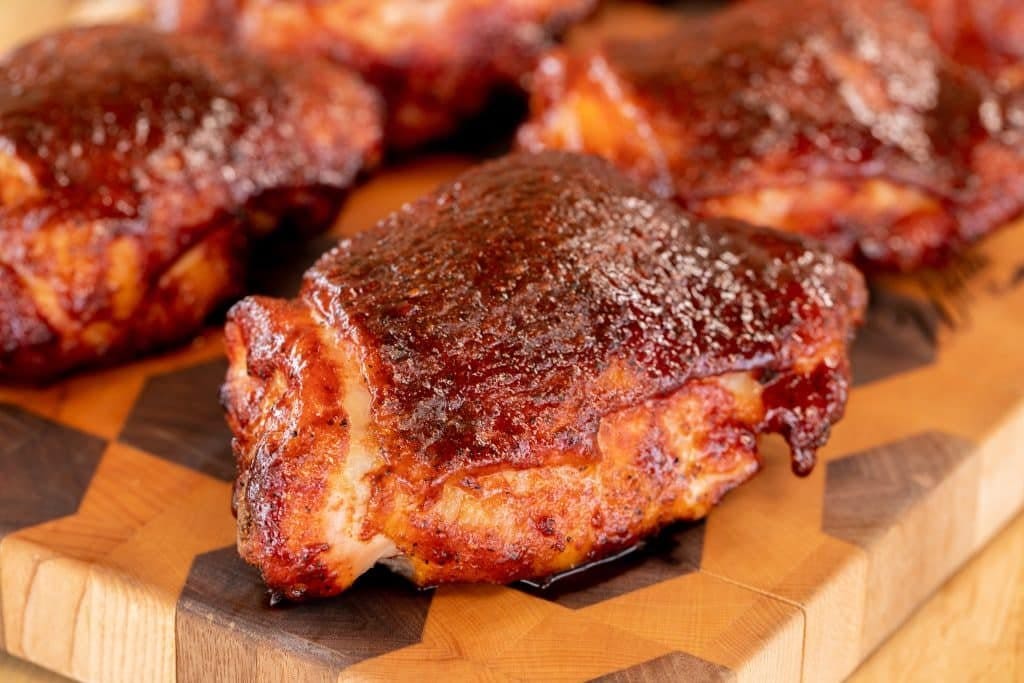
Smoked chicken thighs can be a great way for beginner smokers to get their feet wet in the world of smoking meats.
The rich flavor and moist texture of dark meat make it an ideal item for those who want to learn the basics and gain confidence in slow cooking at low temperatures over several hours.
With just a few simple tips and tricks, smoked chicken thighs become a delicious centerpiece for any occasion.
When choosing chicken thighs for smoking, look for fresh, organic if possible.
Partially thawed or frozen thighs will take longer to cook or may not even reach a safe internal temperature before burning on the outside—so aim as close to room temperature as you can when starting out with your smoker.
To ensure juicy results while keeping them tender, choose bone-in skin-on options so they stay moist throughout their time in the smoker; however, feel free to experiment with various cuts such as boneless/skinless breasts or wings during your next smoke session.
For added flavor, before you start smoking, marinate them overnight ahead of time!
For beginners wanting to use indirect heat found in most traditional smokers, try putting some hardwood chips like applewood above/beside your charcoal firebox (or electric element) to prevent flare-ups that cause direct heat exposure ruining delicate food items like chickens’ legs & wings, or thinner proteins like fish fillets.
Once it’s been prepped according to preference – add salt & pepper seasoning two hours prior to pulling it off – then let ’er rip on the smoker rack!
8-10 hours is recommended if using woodchip chunks over live fire coupled with 3–4oz cubes down below on top of charcoal – prepare more fuel than initially expected because guests won’t mind eating it up!
3. Chicken Wings
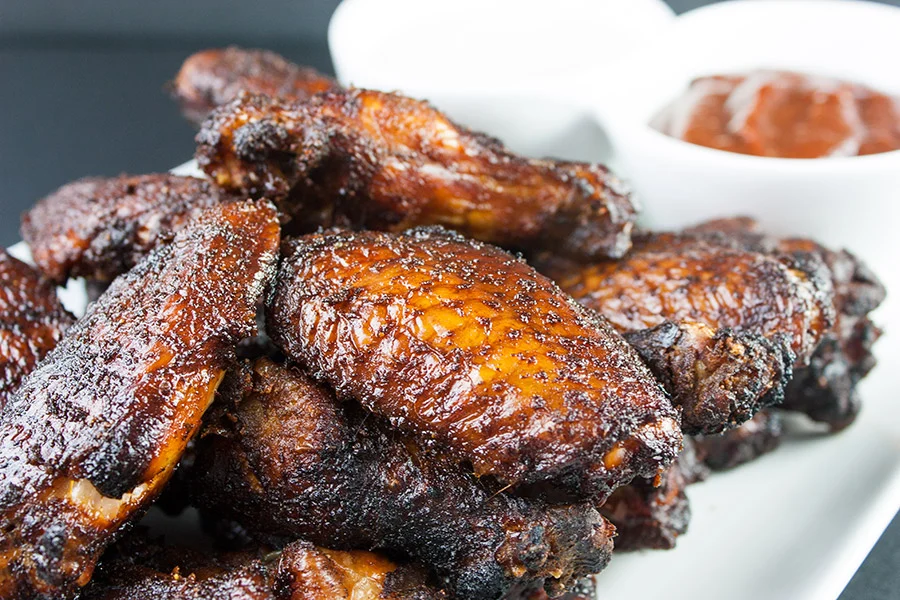
Smoked chicken wings are a great beginner dish for those wanting to learn how to use a smoker. Chicken wings cook quickly, have lots of fatty bits that take on smoke flavoring particularly well, and can be enjoyed by all ages!
Picking the right type of wings is key.
For ease when smoking, we recommend going with bone-in options (such as jumbo chicken wings), as these hold flavors better than already skinless ones. Regardless of what you get though, always make sure to rinse them off before marinating or seasoning them—it’s just good practice.
When it comes to choosing seasonings or rubs for the wings, using bold but simple spices like paprika and garlic powder really makes them stand out in flavor while still being quick and easy to prepare.
Other potential seasonings include cumin powder and onion powder – look through your spice rack and find out what tastes will work best together!
As a chef tip: If you want an extra bit of tanginess in your finished product without adding a lot of time under the fire, try brushing some honey onto the cooked smoked chicken wing right after they come off your smoker—the sweet glaze really emphasizes those delicious smoky flavors!
4. Smoked Turkey

Smoked turkey is one of the best ways to get your feet wet in the world of smoking meat.
Turkey can easily be smoked on a charcoal or gas grill and requires very little experience to make a delicious smoky-flavored meal.
When selecting a turkey for smoking, you’ll want one that is at least six to eight pounds- anything smaller than this will dry out too quickly during the long cooking process.
Also look for eggs with unwrinkled, vibrant-colored skin which indicates they have not been frozen or injected with saltwater solutions, as these processes will affect the flavor and texture of your finished smoked turkey.
Chef Tip: To enhance the smoky flavor and add moisture during cooking, we recommend brining your bird before you smoke it. To do so, submerge your whole turkey (or pieces) in salted water overnight prior to smoking.
This pulls moisture into the bird’s muscles and begins breaking down proteins creating a wonderfully juicy bird!
For smoking beginners, start with indirect heat; place lit charcoals on either side of an empty space between them using both deflectors from direct heat so you can maintain low temperatures ranging from 225F – 295F over approximately 3 – 6 hours (depending on your size).
Allow 10 minutes per pound of uncooked weight when calculating how long it takes to cook all the way through without drying out or becoming overcooked/overly done beyond enjoyable eating quality levels.
A calibrated digital thermometer allows accurate temperature readings when checking for doneness in order to avoid any guesswork associated with timing estimations.
5. Baby Back Ribs

Smoking baby back ribs are a great way to get started with smoking meat.
Baby back ribs are typically juicy and not as fatty compared to pork spare ribs, so they can easily take on the smokey flavors of your favorite wood chips or pellets.
Tips:
- To start off, you’ll need to season your ribs with your favorite dry rub before adding them to the smoker. The longer you let them sit in their rub, the more flavorful the flavor will be once smoked!
- Smoke baby back ribs on low heat for about 4 hours for best results. With temperatures set between 250-275 degrees Fahrenheit, these delicious cuts of meat can turn out amazing every single time! Move around during this cooking process if needed since different spots in the grill may have varying levels of temperature at any given moment.
- After 4 hours (or when they appear slightly browned on top) use an instant-read thermometer like a Thermapen Mk4 and make sure that the internal temperature has reached 205°F (96°C). This ensures perfectly cooked meat that is just right inside and outside!
6. Spare Ribs

For those new to smoking meat, spare ribs are an excellent place to start.
This cut of pork comes from the belly side of the rib cage and is generously marbled with fat that will help keep the meat moist and juicy while cooking over low heat.
Spare ribs come in two types: St. Louis-style or baby back ribs (also known as loin back). St. Louis-style ribs are flatter compared to baby backs, but both can be cooked successfully in a smoker if done correctly.
The cook time will vary depending on size and thickness but usually takes anywhere between four and six hours total at 225 degrees Fahrenheit/107 Celsius until they reach an internal temperature of 185F/85C when tested with a meat thermometer.
To add flavor as well as moisture during the cooking process you should use a dry rub or create your own flavorful marinade prior to smoking them for up to two days before your BBQing session begins.
From there, all you need is patience for these succulent treats!
7. Prime Rib / Standing Rib Roast
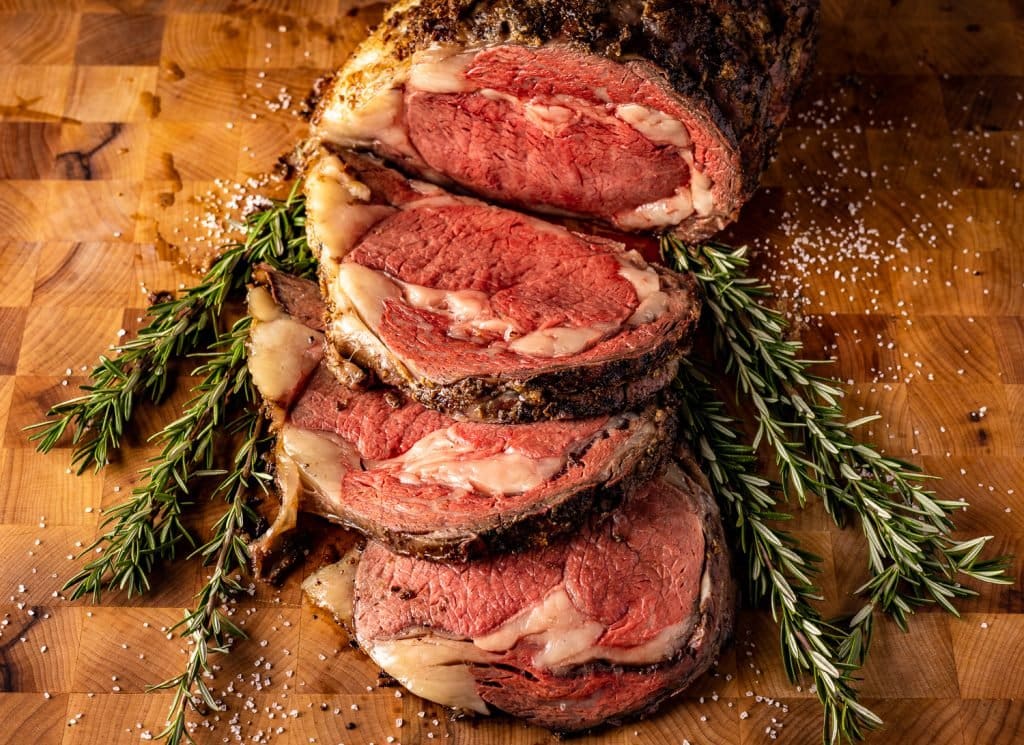
Prime rib or standing rib roast is a great meat to start with if you’re just getting into smoking. This cut of beef has a wonderful flavor and when cooked properly, has a succulent interior that is full of juicy flavor.
To prepare this hunk of deliciousness, season it liberally with salt, pepper, and your favorite BBQ rub or spices.
It’s best to let the seasoned prime rib sit overnight in the refrigerator so that the flavors can really sink in before cooking.
Smoking your prime rib helps add loads of complex wood-fired flavors that will make it even tastier than oven-roasting alone!
The warmer temperatures from slow-smoking also help to bring out more juicy fat content from the cut itself which further enhances its flavor.
As for what kind of wood you should use for smoking your prime rib?
Generally, hardwoods are preferable since they produce clean smokey flavors without overpowering them too much. Hickory and mesquite are two classic choices but feel free to experiment with applewood or other woods as well!
8. Smoked Pork Shoulder
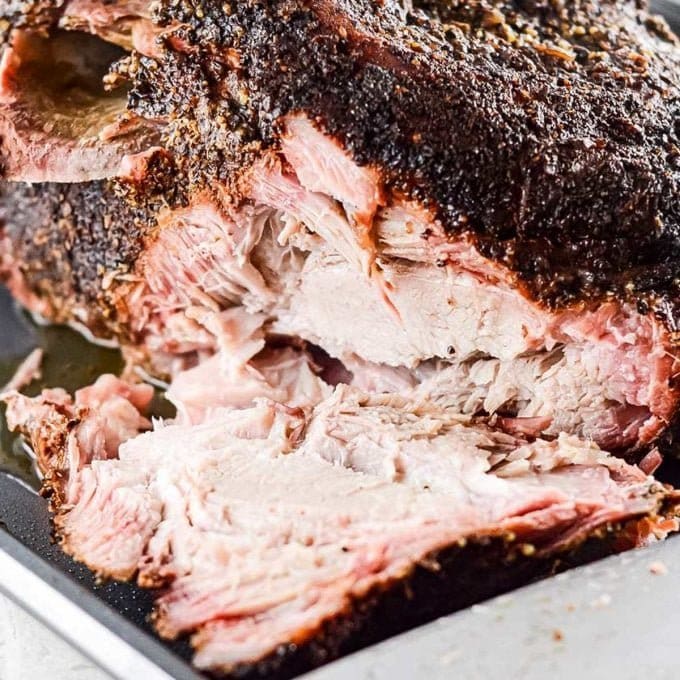
Smoked pork butt, also known as pork shoulder, is an ideal cut of meat to get started with smoking.
This tough region of the pig contains a lot of flavorful fat and connective tissue that makes it perfect for turning into delicious pulled pork sandwiches or tacos.
The key to cooking this cut correctly is to cook it low and slow at around 225F (107C). This will give you the juiciest and most tender results when the smoking process is completed.
For added flavor, season your pork butt with a combination of spices such as garlic powder, onion powder, cumin, smoked paprika, and pepper before starting the smoke session.
When it comes to choosing which type of wood to use in your smoker make sure you go for something mellow like applewood or hickory so you don’t overpower your dish with too much smokiness.
It usually takes 8-10 hours on average depending on size!
Once cooked thoroughly let rest until cool then shred apart enjoy!
9. Pork Belly (aka bacon)
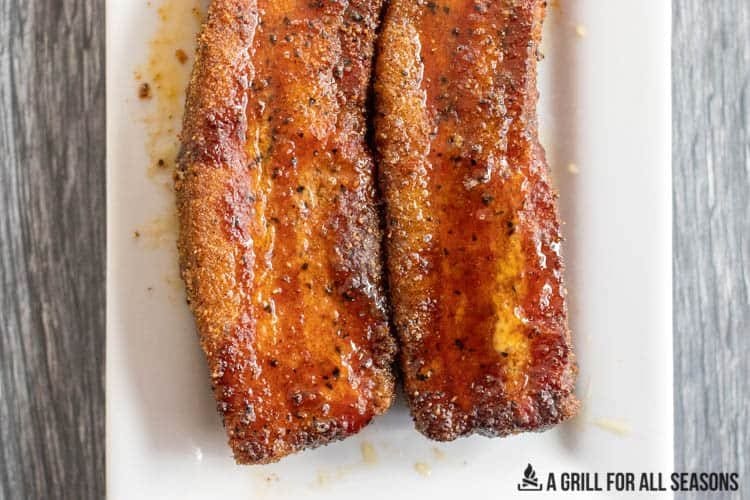
Smoking pork belly is a great way for beginners to begin their foray into the world of smoking meats. The process does take some patience, as with any smoked dish, but the results are worth it in flavor and texture.
The pork belly will be cooked over indirect heat at a low temperature (about 225°F) for several hours until it becomes tender and juicy.
A flavorful dry rub can be applied beforehand to really get all that good smoky flavor on the outside of the meat when you’re finished cooking.
Pork belly can also absorb other flavors easily so feel free to experiment! Try adding different herbs and spices or marinating before cooking for an extra punch of flavor.
When done correctly, pork belly makes a delicious side dish or main course. It pairs nicely with roasted vegetables or mashed potatoes—or just have it by itself straight out of the smoker!
10. Beef Ribs
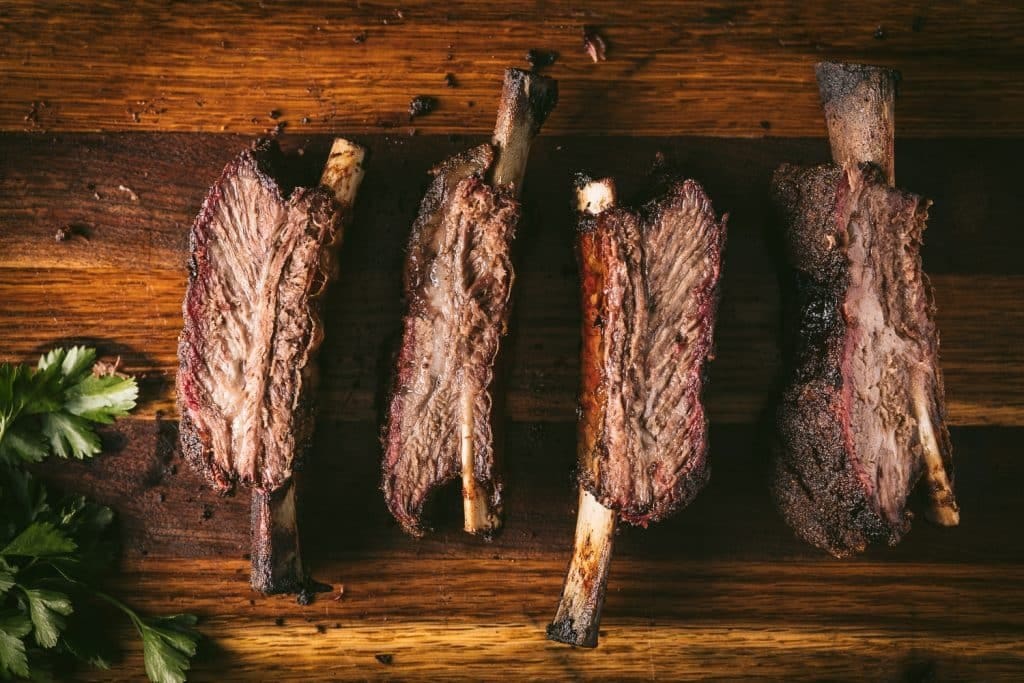
Smoked beef ribs are a great introduction to the world of smoking meat.
They are relatively easy to prepare and can be cooked low and slow over indirect heat for an incredibly tender, tasty result.
Beef ribs come in two main types – short ribs or a back cut known as the “plate” cut. Both cuts are flavorful sources of protein with plenty of fat content that will baste them throughout their cooking to keep them moist.
Short ribs have more bone exposed, so they absorb smoke more easily than the plate cut, which is better suited for braising or barbecuing whole–but it all depends on taste preference!
When seasoning your beef ribs for smoking, opt for rubs that contain sweet notes like brown sugar and smoked paprika with earthy spices such as oregano and cumin.
You can also add bold flavors such as garlic powder along with black pepper for some excitement.
Smoke your beef rib recipe at a temperature between 225-275 degrees Fahrenheit until internal temperatures reach 195-205 degrees Fahrenheit then allow the meat to rest fifteen minutes before serving full flavor every time!
11. Short ribs
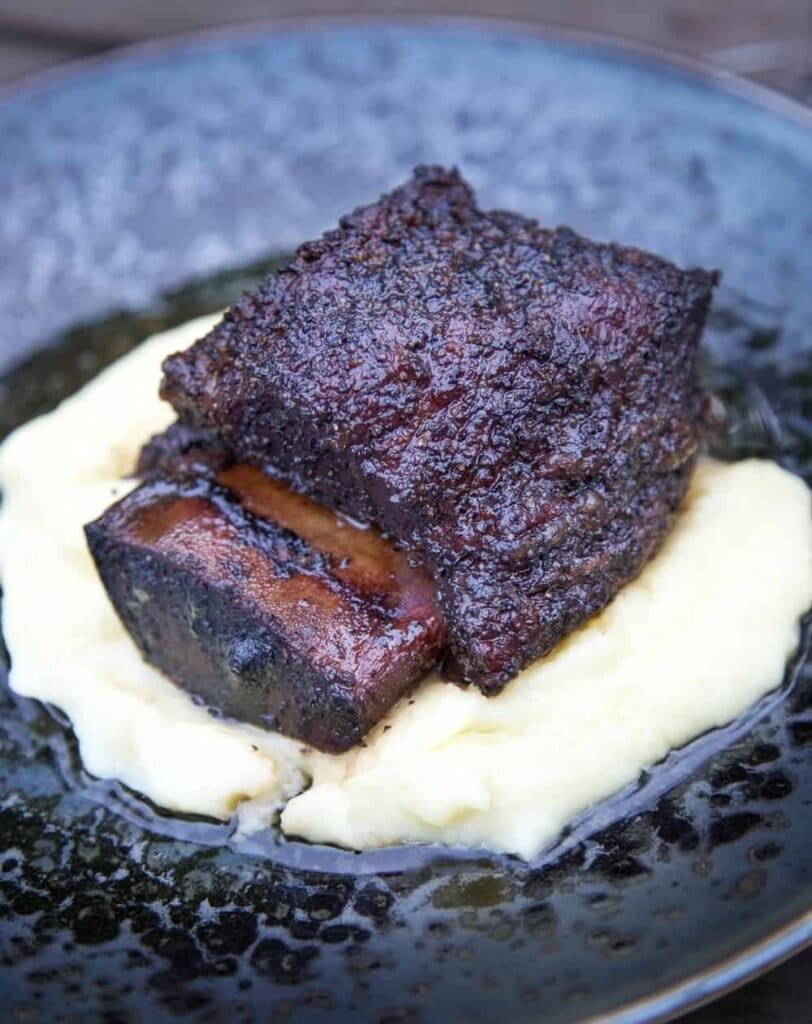
Short ribs are an ideal cut to start off with when it comes to smoking meat.
Because they’re relatively large, they don’t dry out too quickly and can stand up to more intense smoke flavors.
When purchasing short ribs for smoking, look for those that have a nice marbling of fat throughout the meat as this will add both juiciness and great flavor during the long smoking process.
Preparing shortribs for smoking is easy; simply season them generously with salt and pepper before placing them over low-medium heat on your smoker or BBQ.
Make sure your heat source is indirect – meaning not directly under the sections of rib – as you do not want them to cook or char too quickly, but instead receive indirect smoke exposure as evenly as possible.
This should take around 2 hours depending on the size and type of smoker/BBQ being used.
To check if they are done correctly, examine the color at this two-hour mark: fully cooked ribs will be a deep mahogany color through all sections, while any pinkness indicates that further cooking time is needed – usually around 30 minutes extra per side should do it!
Now enjoy your tasty smoked short rib experience!
12. Lamb Shoulder

Smoked lamb shoulder is a great choice for beginners who are just starting to get the hang of smoking.
This type of meat has an impressive amount of flavor and succulence when cooked low-and-slow at 150-165°F for several hours, resulting in tender, juicy pulled chunks of lamb.
The secret to achieving maximum taste from this cut is selecting top-quality marbling. Buying bone-in helps ensure that you get your desired level as well as improved texture in the finished product.
You can also add various marinades or dry rubs with spices like garlic powder, rosemary, and thyme before cooking to really elevate the flavor profile.
If you’re looking for something easy yet sophisticated enough to impress guests, smoked lamb shoulder will be sure to hit that mark!
13. Sausage

Smoked sausage is a great meat for beginner smokers because there are relatively few steps involved and it will pair well with many different seasonings, sauces, and sides.
Smoked sausages can be pre-marinated or you can use your own ingredients to create unique flavor combinations.
Popular marinades include beer, apple juice, brown sugar, and spices like coriander, cumin, thyme, or chili flakes.
You’ll want to choose a link-style sausage as they hold their shape better while smoking than bulk varieties do and they’re easier to handle when transferring them in and out of the smoker.
Smoked sausages don’t require lengthy cooking times so they work well in low-heat situations such as charcoal grills and inexpensive electric smokers – perfect for those just getting started!
Smoked sausage pairs best with light fruit side dishes such as grilled peaches or mixed green salads topped with cranberry vinaigrette.
The smokiness from the sausage balances the sweetness of these accompaniments perfectly creating an explosion of layered flavors that will tantalize your taste buds!
14. Salmon
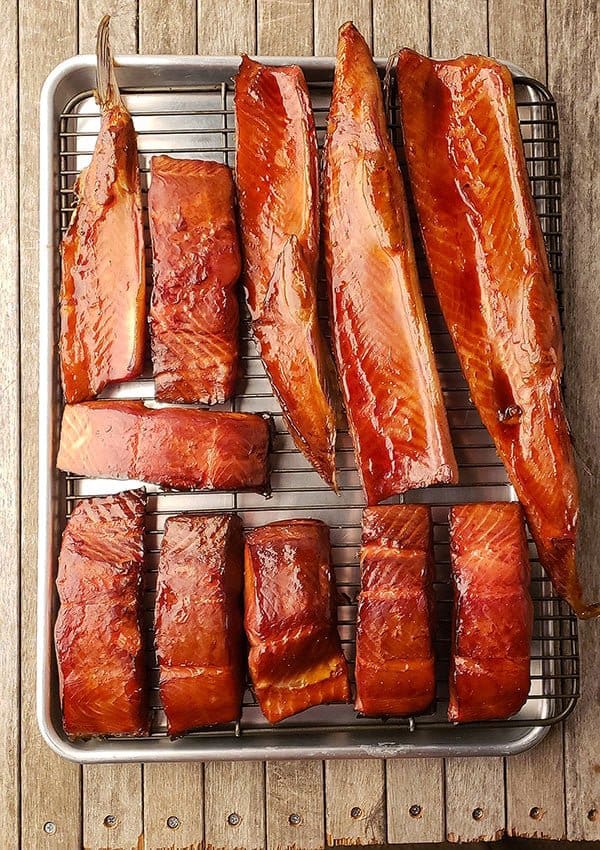
Smoked salmon is another great place for beginner smokers to start.
Its delicate, mild flavor pairs great with some of the classic smoked meats like pork, beef, and poultry.
Salmon fillets are easily portioned into individual servings that can be wrapped in smoke-diffusing materials such as foil or parchment paper so they stay flavorful without drying out too quickly.
When the smoke wraps around them it adds an amazing depth to their flavor!
Your wood selection can also have a big impact on the flavor you create when smoking salmon — different woods will impart unique flavors and aromas that your guests will notice.
Common choices include hickory and mesquite which provide warm tones of sweetness, applewood for its classic fruity notes, or pecan for smoky caramel undertones.
Finally, when it’s done smoking you’ll want to cool it down before serving; this helps retain moisture as well as the quality of taste.
Serve up your perfect smoked salmon with fresh lemon wedges – then enjoy all your hard work!
15. Beef Brisket

Smoking beef brisket is the perfect way to get familiar with the basics of smoking meats.
The cut itself is easy to find, and it cooks up juicy and flavorful every time.
The key to making a great smoked brisket is choosing the right type of meat.
Look for a whole untrimmed piece that has at least 1 centimeter marbling throughout.
This fat content will help keep your brisket moist and tender as it smokes.
When you are ready to cook, trim off any excess fat or silver skin from the top of your cut before seasoning with a rub made from salt, pepper, garlic powder, onion powder, chili peppers, or other desired spices.
Place your seasoned brisket in a smoker preheated between 200°F and 250°F (93°C – 121°C) over indirect heat for 10 hours or until internal temperature reaches 202°F (95°C).
To enhance flavor add some apple wood chips or hickory chunks into the smoker as well.
Allow some time for resting when finished so juices remain within the meat—at least 30 minutes but ideally up to 3 hours!
Serving them warm with sides like grilled vegetables or freshly baked rolls makes this an especially satisfying meal that even beginners can master!
16. Tri-Tip
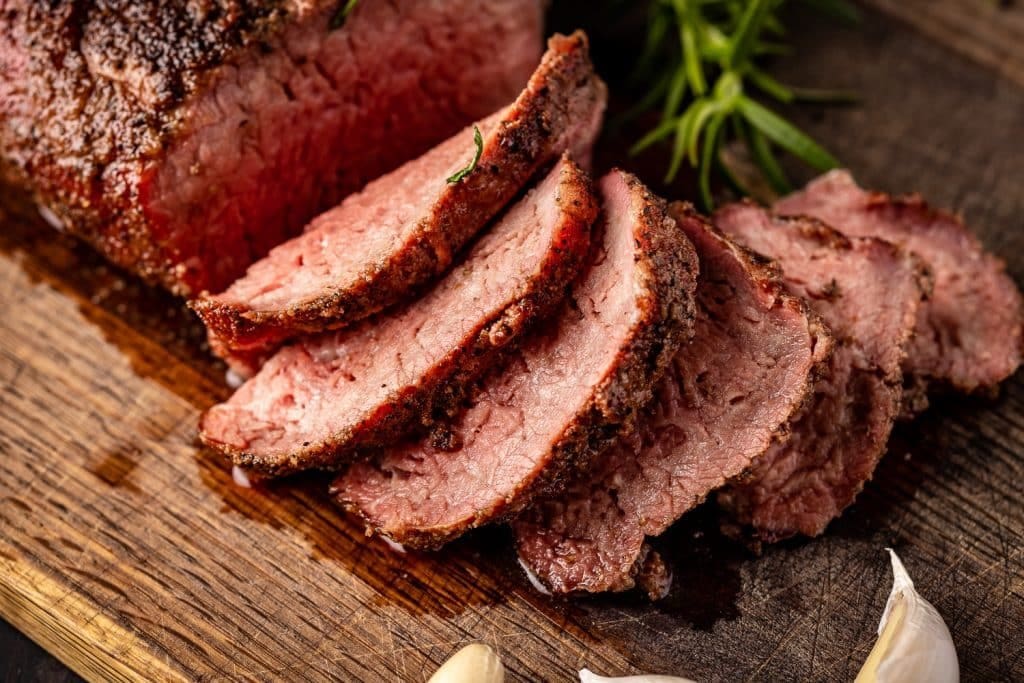
Tri-tip is a great choice for beginners who want to give smoking meats at home a try.
This flavorful cut of meat can easily be found in most grocery stores and will add an unbeatable flavor to your meal.
The tri-tip comes from the bottom sirloin, located near the rear leg of the animal.
It’s usually triangular in shape and characterized by a rich marbling throughout, making it perfect when slow cooking or smoking.
Slow cooking or smoking over indirect heat allows the tri-tip’s natural flavors to shine through while creating its signature juicy tenderness that we all love far better than any dry beef dish.
Try using apple wood chips to smoke your tri-tip for some added sweetness and complexity in flavor.
Once finished, serve this succulent meat with some hearty sides like roasted potatoes, mac & cheese, garlic bread, etc., as well as an easy Chimichurri sauce which would go perfectly with delicious smoked Tri-Tip!
17. Venison

Smoking venison is a great way for beginners to learn the basics of smoking meat.
The key to successfully smoked venison is selecting the perfect cut and giving it plenty of time in the smoker.
The best cut for smoking is flank steak or sirloin tip due to its thin shape which makes it easier to cook through without drying out.
Brining is recommended before adding any spices, as it will keep your meat moist while also layering on flavor.
After brining, you can add your favorite spice rubs or marinades before placing them into the smoker and slowly cooking over oak wood until medium rare – about 140-145 degrees Fahrenheit.
Venison has a strong but subtle gamey taste that pairs wonderfully with smoke flavors like hickory, applewood, mesquite, or cherrywood.
It’s important not to smoke too hot since this will dry out the venison quickly; aim for temperatures between 225-275 degrees Fahrenheit depending on cuts used and the time needed in the smoker.
Smoked Venison pairs well with traditional sides such as cheeses (like cheddar or provolone) sweet potatoes, mashed potatoes, fried onions rings, applesauce, and coleslaw among others!
For a unique twist try pairing smoked venison with warm salads high in nutrition like quinoa salad or cucumber salsa!
18. Duck

For those starting out on their smoking journey, duck is an ideal meat, to begin with.
Whilst it can be intimidating due to its dark color and strong flavor, it is incredibly versatile with a host of different recipes available online.
Duck has a unique flavor profile that comes from the fat layer found underneath the top skin of each bird which ensures your smoked protein will be juicy and tender when cooked correctly.
Smoked duck can easily be used in salads as well as sandwiches or tacos; during cooking, you’ll also benefit from lots of smoky aromas filling your kitchen (or backyard)!
In terms of time taken to cook, duck takes around 4-5 hours for a whole roasted bird – making this an excellent option for both beginner smokers and those short on time.
Finally, if you’re concerned about leftovers then don’t worry – turkey makes a great substitute for chicken in any recipe!
19. Corned Beef
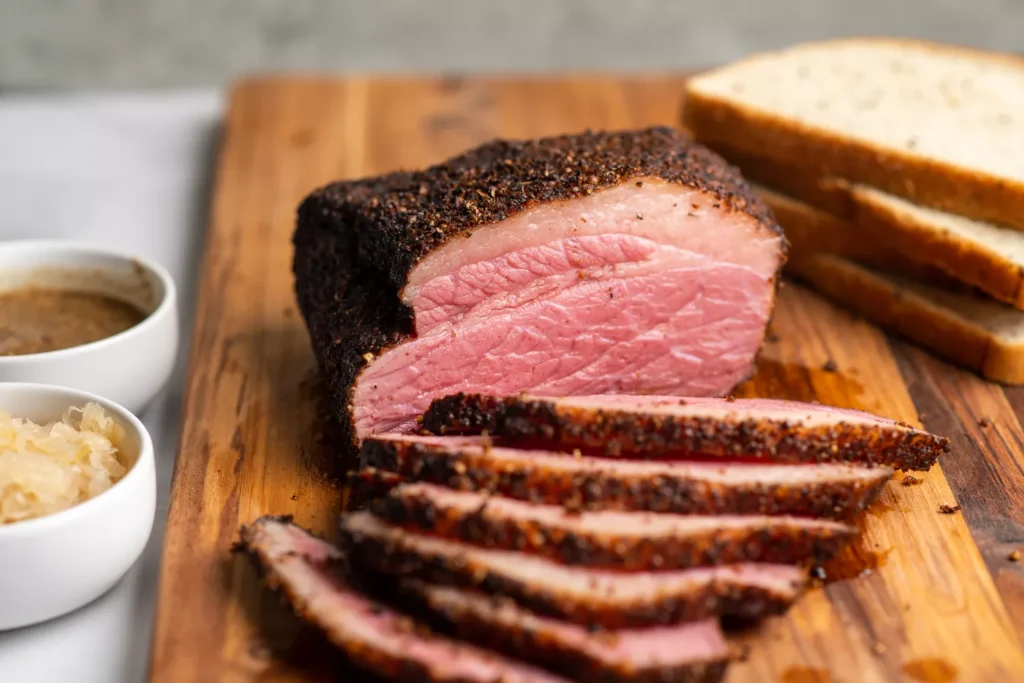
Corned beef is a great place to start for those just learning how to smoke or even for the experienced smoker who wants something hearty and delicious.
The study cut of salted and cured beef brined in a mixture of herbs and spices can be slow smoked over wood chips until it’s incredibly tender and full of flavor.
The key to success when smoking corned beef is not oversmoking it; while you want the meat to be nicely smoky, you don’t want it overly dry or tough.
Smoking the corned beef at low temperatures (around 180 degrees Fahrenheit) will help ensure its tenderness.
For added flavor, you can rub the outside with herbs such as rosemary, thyme, garlic powder, salt, and pepper before smoking it for an extra flavorful crust on the outside.
Once your brisket is cooked all the way through, serve slices of hot corned beef on rolls with some spicy mustard and crispy melted cheese – yum!
20. Ham

Smoked ham is a great way for beginners to enjoy the delicious flavor of smoked and cured meats without taking too much of a risk.
It’s inexpensive, easy to find, and takes very little prep work.
When looking for a piece of meat to smoke at home, you want one that has the right fat-to-meat ratio for that perfect balance between moisture and tenderness: hams are usually just about ideal.
Look for a pre-cooked ham with 4 – 8% fat content, this will produce the most succulent end result!
For smoking your ham you need an indirect grill set up or smoker box with hardwood chips (such as apple, oak, or hickory).
Rub your smoked ham with herbs such as rosemary or basil beforehand, then coat generously in brown sugar before putting it into the heat source.
Smoke your ham at 225℉/107℃for approximately 2 hours and add chips every 30 minutes until done (145°F/62°C internal temperature).
After cooking let it rest covered in aluminum foil before serving it alongside potatoes and vegetables or on sandwiches.
Top it off with slices of provolone cheese cooked over medium heat on top of your sandwich – delish!
7 Things I Wished I Knew When I First Started Smoking Meat
- Controlling the Temperature: An important element of smoking meat is maintaining a low and slow cooking temperature. When you first start out, it is easy to get carried in the smokey flavor of the wood chips/wood pellets and forget about controlling your heat. Avoid having hot spots by keeping your flame low, using lump charcoal, or avoiding burning too many hardwoods.
- Direct vs Indirect Heat: It’s essential to understand that there are two different types of heat when smoking meats – direct heat and indirect heat. With direct heat you will be directly grilling over the coals whereas with indirect heating, you’ll have your lit coals on one side and whatever meats you are cooking on another side where they will cook more slowly without being exposed to too much heat at once. This technique allows for some great caramelization of the proteins as well as even cooking throughout.
- Using A Meat Thermometer: A very important tool when smoking meat is an accurate thermometer! Investing in a thermometer will greatly help with knowing when your smoked meats are done without having to guess if it’s properly cooked or not”.
- Allowing Meat to Rest After Cooking: Many people overlook the importance of letting cooked meat rest for a few minutes after being removed from the smoker. This allows for maximum moisture retention and allows the internal juices to re-spread throughout the cut, creating a juicy, tender flavor profile.
- Using Different Types of Wood For Smoking: The type of wood you use can add unique flavors that enhance your smoked meats in unexpected ways. When starting out, experiment with different types like hickory, applewood, or mesquite and note which ones provide the best results!
- Marinades & Dry Rubs for Maximum Flavor: Adding flavorful marinades or dry rubs pre-cooking is key when it comes to getting delicious results every time! Consider simple mixtures such as tomato paste with garlic powder and onion powder; Worcestershire sauce spiked with paprika and cayenne pepper; brown sugar plus spices like fennel seed and cracked coriander – all bringing explosive yet balanced flavor notes worth exploring!
- Start Simple & Work Up To Complex Recipes: As you gain confidence smoking meat, try developing more complex recipes by experimenting with new combinations of marinades, rubs, glazes, or sauces. Taking risks will depend on learning basic techniques first – stacking layers of flavors can produce amazing dishes not just in taste but also in presentation as well!
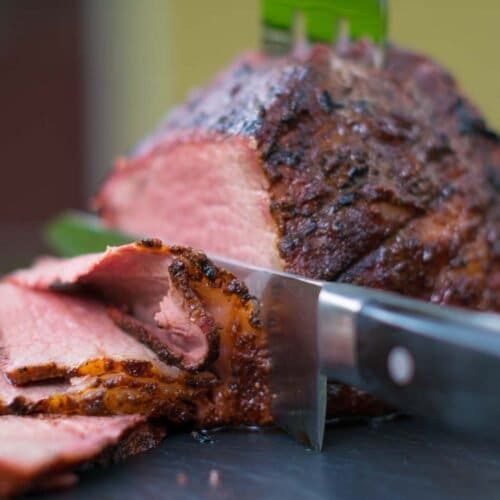
20 Best Meats to Smoke for Beginners: The Ultimate List
Ingredients
- Whole Chicken
- Chicken Thighs
- Chicken Wings
- Smoked Turkey
- Baby Back Ribs
- Spare Ribs
- Prime Rib / Standing Rib Roast
- Pork Butt/ Pork Shoulder
- Pork Belly (aka bacon)
- Beef Ribs
- Short ribs
- Lamb Shoulder
- Sausage
- Salmon
- Beef Brisket
- Tri-Tip
- Venison
- Duck
- Corned Beef
- Ham
Instructions
- Select your favorite meat from this article.
- Organize all the required ingredients.
- Prep your smoked meat recipe in 2 hours or less!
Jenny has always been passionate about cooking, and she uses her platform to share her joy of food with others. Her recipes are easy to follow, and she loves giving tips and tricks to help others create their own unique culinary creations.

